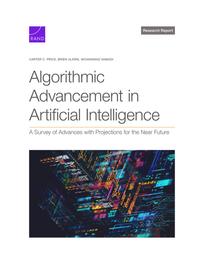Algorithmic Advancement in Artificial Intelligence
A Survey of Advances with Projections for the Near Future
ResearchPublished Apr 23, 2025
As artificial intelligence (AI) capabilities develop and advancements are made in commercially available AI products, concerns about the security implications of AI have increased. In this report, the authors make evidence-based projections about the direction, pace, and indicators of algorithmic improvements. They describe several possible channels for AI algorithmic improvement and explore the implications of such progress.
A Survey of Advances with Projections for the Near Future
ResearchPublished Apr 23, 2025

With notable advancements in commercial products based on large language models, the topic of artificial intelligence (AI) has expanded in the public discourse. And, as AI capabilities develop, there has been increasing concern about their economic and security implications. In this report, the authors make evidence-based projections about the direction, pace, and indicators of algorithmic advancements to help inform policymaking. They describe possible channels for algorithmic improvement related to AI and explore the implications of how progress might be made along each of those channels. They identify the empirical mechanisms by which new algorithms are introduced and how to define an improvement by looking at algorithms from numerical analysis, operations research, and computer science.
The authors identify two key drivers for near-term advancement in AI systems: new synthetic data generation methods that allow for broader improvements and alternative architectures that are more data efficient. Without these types of improvements, smaller models are likely to dominate the market. With one advancement, small models will likely be the predominant AI models used, but there will be roles for large models. If there is advancement along both drivers, larger models may deliver meaningful and more-useful capabilities.
This work was independently initiated and conducted within the Technology and Security Policy Center of RAND Global and Emerging Risks using income from operations and gifts from philanthropic supporters. A complete list of donors and funders is available at www.rand.org/TASP.
This publication is part of the RAND research report series. Research reports present research findings and objective analysis that address the challenges facing the public and private sectors. All RAND research reports undergo rigorous peer review to ensure high standards for research quality and objectivity.
This document and trademark(s) contained herein are protected by law. This representation of RAND intellectual property is provided for noncommercial use only. Unauthorized posting of this publication online is prohibited; linking directly to this product page is encouraged. Permission is required from RAND to reproduce, or reuse in another form, any of its research documents for commercial purposes. For information on reprint and reuse permissions, please visit www.rand.org/pubs/permissions.
RAND is a nonprofit institution that helps improve policy and decisionmaking through research and analysis. RAND's publications do not necessarily reflect the opinions of its research clients and sponsors.